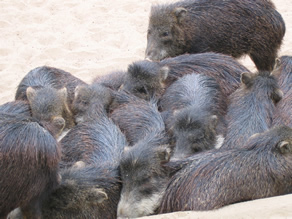
Wild Pigs
Rodent?
Javelina – (pronounced “have-a-lean-a”), a mean, nasty, evil smelling, highly destructive little animal with a bad attitude. I have heard of them being called a “wild pig” - not true. I have also been told that they’re a member of the “rat” or “rodent” family as well, but that really isn’t true either. Also, some folks refer to them as “razor backed pigs” after the pigs brought to the east coast by early European settlers and escaped to run wild in many parts of the nation. The “razor back” is definitely not related to these animals in any way.
Definition
Excerpted from Wikipedia, the free encyclopedia – the Javelina: “A peccary (plural peccaries; also
javelina or skunk pig. Peccaries usually measure between 3 and 4.3 feet in length, and a full-grown adult usually weighs between about 44 to 88 pounds. In many other countries, especially in what we refer to as the “developing world”, they are raised on farms and are a source of food for local communities. Their skin is both rigid and strong but also soft and ideal the leather glove
construction.”
Behavior
If cornered, they can be very dangerous because of the “pig” tusks and their excellent knowledge of how to use them. They are not afraid of humans, but they will try to get out of the way and move (as a group) somewhere else.
According to the Game and Fish Department, “the javelina are herd animals with herd sizes averaging 8 to 9 animals. They establish their Territory by using droppings and their body odor to mark these areas. Territory size varies but averages about 750 acres.”
I’m not sure what they do at night, but in the summer weather, they try to dig a small indentation in the shade somewhere and wait until the weather is cooler. I strongly suspect they do come back to those “nesting” holes at night as well but they are usually up and gone by daylight.
Thieves in the Night
They love to be squatters in the hay storage of the farmers or ranchers, and will destroy the animal feed stored for the ranch animals. They don’t benefit the facilities constructed for the retention of the feed either. Unless a wooden box is built quite sturdy, the box is no challenge for the appetite of a hungry Javelina, especially the younger ones – they can squeeze in a pretty small opening and mom or dad can rip apart a wooden case unless it’s very well built.
feed stored for the ranch animals. They don’t benefit the facilities constructed for the retention of the feed either. Unless a wooden box is built quite sturdy, the box is no challenge for the appetite of a hungry Javelina, especially the younger ones – they can squeeze in a pretty small opening and mom or dad can rip apart a wooden case unless it’s very well built.
Eating like a Pig
Their food includes small animals but they prefer roots, grass – (baled farm hay is choice), seeds, fruit and some cacti, especially the prickly pear. Their jaw muscles and teeth have adapted for crushing hard seeds and slicing into plant roots. Those tusks are also excellent tools for defending against predators as well. They can rub those tusks and make a chattering noise to warn predators not to get too close. They are aggressive enough that it is considered very unwise to attempt making pets of them. (State sources claim it is impossible.)
Reducing their Numbers
As near as I can find, it is illegal in the Southwest to kill them, except there is apparently a season for hunting them with hunting licenses, good both in the spring and the fall. If you’re considering this, check into the local laws in your area.
a season for hunting them with hunting licenses, good both in the spring and the fall. If you’re considering this, check into the local laws in your area.
Southwestern Animal
Now, I’m not here to tell you what to do, but for this transplant from the northwest, this is an animal I’ve never been in contact with before, and I really don’t want to again. Twice they have destroyed our garden as they go from one destination to the otherone, and used our veggies for their salad.
We did find that they apparently can’t hop or climb very high. Our raised garden (3 concrete blocks high) keeps all of them out except for the most determined. It didn’t stop the deer though, but then, that’s another story.
Roy
January 2013







